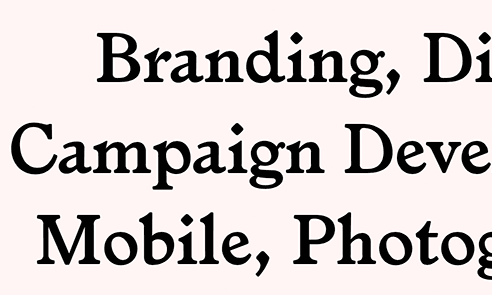Avant Garde Black Font With Stroke
LO instruction, specifying 80 attribute set. Column ll8 attributes of pic objects l58 attributes specification line, global table l l4 attributes, global table ll6. In 57 automatically-sequenced lists 56 examples of 57 selecting marks for 56 Avant Garde Demi font, example of 340 Avant Garde Gothic Book font, example of 34l. Download avant garde book font free at Best-Font.com, database with 114947 web fonts, truetype and opentype fonts for Windows, Linux and Mac OS.
ITC Avant Garde GothicInspired by the 1920s, ITC Avant Garde Gothic was designed by and Tom Carnase in 1970. The typeface design was based off the logo Lubalin created for Avant Garde magazine. One cool thing I like about Avant Garde is all the crazy alternate characters it contains like the sloped A and V, although it’s easy to go too far with the alternates—Ed Benguiat once said, “The only place Avant Garde looks good is in the words Avant Garde.” Avant Garde is famously used in the Adidas logo.includes this family for both desktop and web use (with unlimited pageviews). Get the entire Adobe Fonts collection with all.
4) For the fonts bundled with PostScript 3 output devices, there were a number of revisions, which include many common fonts. Where not all accented characters were kerned, those fonts had their kerning extended to add more kerning for accented characters.
Additionally, all these fonts, plus any other fonts in the same retail packages, had the euro character added. Note that both of these changes were made to all Adobe alphabetic fonts as part of OpenType conversion, later on. Here is a list of the families/packages that had this change made while they were still in Type 1 format. 1) Helvetica Narrow was not converted to OpenType.
Avant Garde Medium Font
This font family was developed for use in printers when ROM space was very scarce, so it was created by mathematically squashing Helvetica by 18% (to 82% of the original width), a painful compromise which resulted in distorted letterforms and thin vertical strokes next to thicker horizontals.For general use, Adobe recommends Helvetica Condensed instead, which was actually designed to be condensed, so that stroke widths are unchanged. If an exact match to Helvetica Narrow is needed, many programs, including Microsoft Word, InDesign and Illustrator, allow the user to horizontally scale a font to any desired percentage.
One could use Helvetica LT Std and apply an 82% horizontal scale factor. 7) Some other Adobe Originals had significant additions or modifications. In particular, Lithos Pro and Trajan Pro got real small caps to accompany their all-cap designs. Text entered in lower case will turn into these small caps if one switches from the Type 1 fonts to the OpenType versions. Text entered specifically as caps will remain the same.All fonts with 'Pro' in their names had additional language support added.

This will not cause issues moving from the old version to the new one, but of course if one takes text set using language support not present in the old fonts, and sets it in the old font, depending on the application being used, that text will either be missing (show notdefs) or fall back to some other font. 9) all alphabetic fonts had another 16 characters added, namely the 14 Mac 'symbol substitution' characters, the litre and estimated symbols. 'Symbol substitution' describes a Mac-specific scheme whereby if a certain character was typed in a Type 1 font with StandardEncoding, both ATM and the printer driver would get a generic glyph in the Times style from the Symbol font (it wasn't actually present in the original Type 1 font).
In OpenType, instead of substituting a generic glyph from Symbol, the system infrastructure relies on a glyph being actually built into the font. Adobe's OpenType fonts all have font-specific versions of the former Symbol substitution glyphs, which have different widths than the glyphs from Symbol. The affected characters are as follows: partialdiff, Delta (math), integral, pi (math), product (capital math pi), root, infinity, lozenge (diamond), summation (cap math Sigma), approxequal, ohm (capital math Omega), lessequal, greaterequal. Similarly, there can be changes in the behavior of small caps between the Type 1 and OpenType versions of the font.
With a Type 1 font, one had to switch to another font to get real small caps. If one simply used formatting in the application, the result would be 'faux' (fake) small caps, created by scaling the capitals. Faux small caps have stroke weights that are lighter than the rest of the font, and may be narrower in width. If one switches to an OpenType version of the same font, and it has real small caps merged into the font, and the application knows how to use them when they're available, the faux small caps will be switched for real ones. This is typographically preferable, but will likely result in wider text and possibly cause reflow. Using office-level applications, reflow due to line spacing differences is more likely, thanks to item C5 above.
The difference is because such applications typically use the font's bounding box to determine default line spacing. The added characters in the OpenType fonts can change the bounding box, especially in cases where the OpenType fonts merged what were formerly supplemental fonts in Type 1. The presence of swashes and/or ornaments in the OpenType font often accounts for the most serious line-spacing changes in office-level applications. NOTE: In applications where this is a problem, it can be reduced by setting the text using a specific point-based line spacing rather than the usual 'single spacing' or 'double spacing' kinds of options.

Avant Garde Font Torrent
If you can set the line spacing to a point-based value that is equal to the default line spacing, you should be able to preserve that line spacing when later switching to an OpenType font.